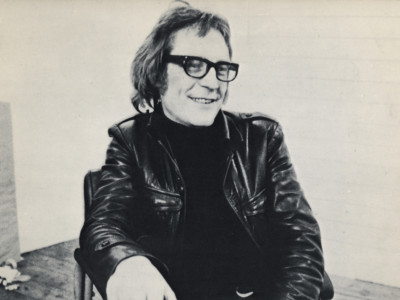
Inside Story: Bill Viola
By Laura Gascoigne
Published on 2 June 2014
The pioneering video artist talks to Laura Gascoigne about mystery, compassion and sacrifice in art, as the first of his two altarpieces commissioned by St Paul’s Cathedral goes on permanent display.
From the Summer 2014 issue of RA Magazine, issued quarterly to Friends of the RA.
Fire and water are recurrent images in your work. Do they feature in your altarpieces for St Paul’s Cathedral?
Martyrs, the first work in the commission for St Paul’s, comprises four vertical plasma screens mounted side by side. Each depicts a person passing through their final moments of life, represented by their interaction with four key elements – earth, air, fire and water. The second work, on the theme of Mary, is still in progress. Kira Perov, my partner and collaborator, has been essential in helping to realise these works.
These subjects suggest compassion and sacrifice.
The act of sacrifice exists in all cultures and can be expressed by all human beings. Everyone knows what it is like to make a sacrifice, large or small, and Martyrs depicts the ultimate sacrifice of the giving of your own life. Yes, compassion and sacrifice are present in the works, but in my mind the pieces also represent birth and death. These fundamental elements that are at the opposite ends of human existence unite the works.
Since Kandinsky’s Concerning the Spiritual in Art was published in 1912, the spiritual has fallen out of artistic fashion. Are you leading a revival?
Actually, I have never tried to revive the spiritual in art. It is already there in one form or another, embedded within the human condition or latent in the cosmos.
How do you feel about creating devotional art for a Christian congregation?
I don’t set out to make art for any particular audience. My works are open to interpretation. I feel that the works are completed when the viewers are present – they bring to the work their own emotions, thoughts, feelings and interpretations.
You have a big show at the Grand Palais in Paris. What’s the difference between exhibiting in a gallery and showing work in a place of worship?
They are not so different as you might think. People come to a gallery for many of the same reasons that they go to a place of worship. Some seek comfort, others seek inspiration, others want a quiet place to meditate with beautiful art, or to spend time looking inwards. Of course, a cathedral has its own history of use and prayer. It is amazing to feel the resonance that is created when art inhabits this kind of space – a whole new conversation takes place.

You were involved in political activism when you were a student at Syracuse University. Did the Occupy protest outside St Paul’s in 2012 affect you?
The Occupy protest in London did not have any impact on the work itself, but changes took place within the cathedral community that may have helped to move the project forward.
Are you a crusader for ‘slow art’ in a fast-spinning world?
I use slow motion in my work to help see details of an event or an image that I would not normally notice. It allows you to look at the whole image and not just part of it because it is going by too fast. It slows us down long enough to experience something in the present, in all of its expansiveness.
Did you ever dream when you started out as an artist that you would be making videos for Europe’s great cathedrals?
No, I had no idea when I was experimenting with video in the early 1970s that the work would lead to these kinds of possibilities. However, already in 1986 I was showing installations in places such as La Chartreuse in Villeneuve-le?s-Avignon, a beautiful former monastery that had wine cellars with dark spaces.
How important is mystery in art? Is art about making the invisible visible?
That is only one part of it. Mystery is all of the things we have yet to experience, and those that we have experienced but are not aware of at the present moment. This is precious and essential for all of us to recognise, for these hidden moments that are tucked away will continue to nourish us throughout our lives.
Bill Viola: Martyrs can be seen at St Paul’s Cathedral from 22 May.
Bill Viola is at the Grand Palais, Paris, until 21 July.
Related articles

Visions from Ukraine
19 June 2024

10 RA Schools stories through the centuries
16 May 2024

In memoriam: Mick Moon RA
1 May 2024